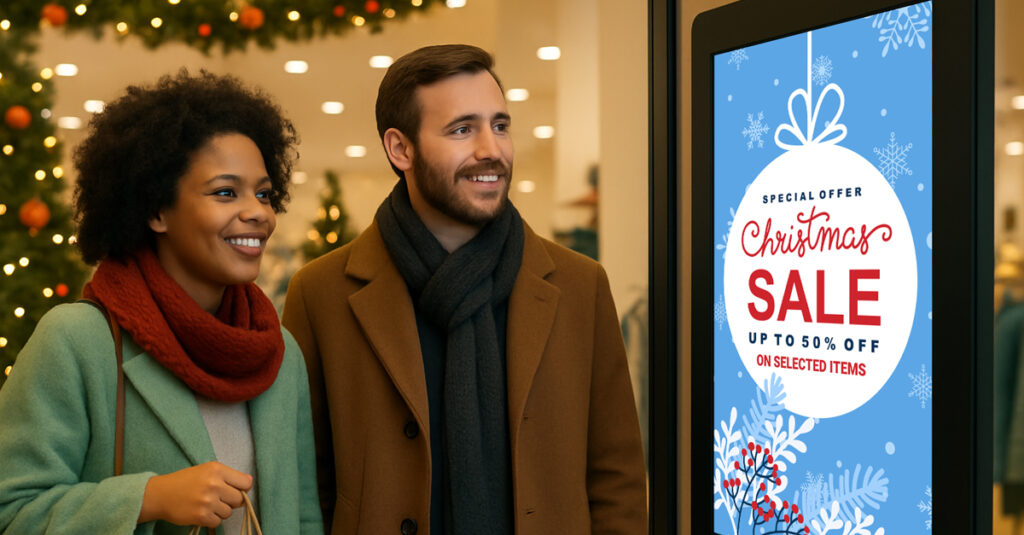Holiday shopping in 2025 is shaped by caution and control. Consumers are researching more, comparing options harder, and demanding convenience on their terms. If you show up late in their decision process, you’re invisible. Shopper Marketing Media helps brands and retailers close the gap with integrated in-store, digital, mobile, and DOOH solutions powered by reporting that proves results.
The Shopper Has Changed
Google’s Holiday Essentials 2025 research shows shoppers demand three things before buying:
- Value confidence (price transparency and promotions)
- Product confidence (reviews, social proof, and trust)
- Convenience (stock visibility, pickup or delivery, frictionless checkout)
On top of that, they blend online and offline behaviours, discovery, validation, and purchase happen simultaneously across search, social, and in-store touchpoints.
What Brands and Retailers Should Do Right Now
- Audit holiday promotions for both in-store and digital consistency
- Ensure DOOH and mobile assets reinforce each other
- Plan retargeting campaigns that extend beyond first exposure
- Lock in attribution reporting with Datalytica to prove performance
Why DOOH and Retail Media Drive Holiday Sales
Retail media is central to holiday campaigns because it meets shoppers at the point of decision. In-store and DOOH placements have proven to shift shopper behaviour and drive measurable sales.
A study from Vistar Media and MFour found that 95% of consumers feel neutral or positive toward retail media ads, and 44% reported making a purchase directly because of exposure.
DOOH ads are also highly action-oriented. Research from OAAA and Harris Poll shows 76% of people who view DOOH ads take an action such as visiting a store, searching online, or making a purchase.
How Mobile Retargeting Extends Holiday Campaigns
Holiday shopping doesn’t end when a shopper leaves the store. Mobile retargeting ensures your message follows them, reinforcing offers and prompting return visits. Combining DOOH with mobile retargeting extends campaign reach beyond physical retail environments, creating consistency across touchpoints.
Proving ROI with Datalytica Holiday Attribution
At Shopper Marketing Media, Datalytica is the engine that connects exposure to outcomes. It’s more than a reporting tool, it’s how we close the loop between in-store, DOOH, mobile retargeting, and actual sales.
Datalytica provides:
- Unified data integration across POS, mobile, and digital platforms
- Incrementality and lift modeling to prove true sales impact
- Real-time dashboards to track performance during the holiday cycle
- Granular reporting by SKU, geography, and retailer
- Transparency that both brands and retailers can trust
The IAB DOOH & In-Store Retail Media Playbook 2024 reinforces the importance of advanced measurement and closed-loop reporting for accountability.
Risks and Pitfalls to Watch
Retail media is powerful, but pitfalls remain. Measurement gaps, inconsistent attribution methods, and siloed reporting can erode trust between brands and retailers.
The IAB’s Quantifying Retail Media In-Store Success report highlights the risk of relying on vanity metrics, stressing the need to link media activity directly to incremental sales.
Without a trusted attribution framework, campaigns risk being undervalued or misaligned with actual outcomes.
This is where Datalytica mitigates risk. By unifying POS, mobile, and digital reporting into one platform, Datalytica eliminates silos and ensures every campaign is tied to real sales impact. Incrementality and lift modeling protect against inflated vanity metrics, while real-time dashboards give both brands and retailers transparency during critical holiday cycles.
Shoppers also expect authenticity. Bazaarvoice research emphasizes the role of reviews and social proof as critical to purchase confidence. Brands that skip these trust-building elements risk falling behind.
Why is DOOH effective for holiday retail?
DOOH is effective for holiday retail because it delivers dynamic, location-based ads to high-traffic areas during peak shopping periods. It boosts impulse purchases, reinforces brand messaging, and adapts in real time to weather, events, and inventory changes—maximizing relevance and ROI during the busiest retail season.
How does mobile retargeting fit into holiday campaigns?
Mobile retargeting fits into holiday campaigns by re-engaging shoppers who viewed products but didn’t purchase. It delivers personalized ads across apps and mobile sites, driving return visits and conversions. During the holidays, mobile retargeting captures high-intent audiences and reduces cart abandonment through timely, relevant messaging.
What metrics matter most in holiday shopper campaigns?
The most important metrics in holiday shopper campaigns are return on ad spend (ROAS), conversion rate, foot traffic, and average order value (AOV). These metrics track performance, measure shopper intent, and quantify impact. High-performing campaigns align impressions and clicks with actual sales during peak periods.
How do brands and retailers benefit equally from integrated shopper media?
Brands and retailers benefit equally from integrated shopper media by sharing data, driving joint sales, and enhancing customer experiences. Brands gain visibility and conversion insights, while retailers boost basket size and shopper loyalty. Collaboration creates a unified path to purchase, improving efficiency and campaign ROI.
Why does reporting matter more this year?
Reporting matters more this year because brands face tighter budgets, increased competition, and higher performance expectations. Real-time insights help optimize campaigns quickly, prove ROI, and justify ad spend. Strong reporting also supports cross-channel coordination, making every marketing dollar more accountable and effective.
What’s the role of retail media vs. traditional holiday ads?
The main difference between retail media and traditional holiday ads is precision and proximity to purchase. Retail media targets in-market shoppers using first-party data on retailer platforms. Traditional ads build broad awareness through TV, print, or radio. Retail media drives conversions, while traditional ads drive top-of-funnel reach.
How much budget should retailers allocate to DOOH?
Retailers should allocate 10–20% of their holiday media budget to DOOH. This range balances high-impact visibility with cross-channel integration. DOOH amplifies store traffic, supports retargeting, and reaches shoppers near point-of-sale. Budget allocation depends on campaign goals, store footprint, and available first-party data.
